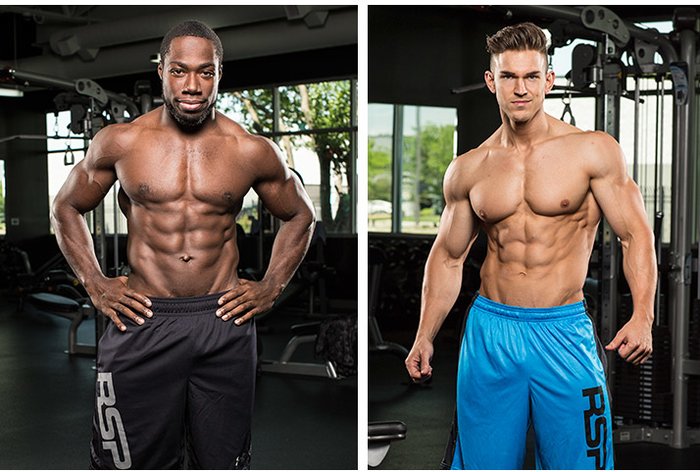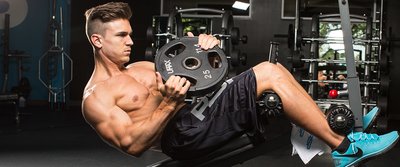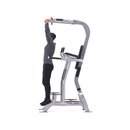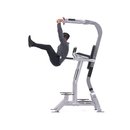If you want a high-performance chest, you've got to bench big and eat big to support massive growth. Likewise, if you want tree-trunk legs, you squat till you drop and eat high-protein foods to pump up your wheels. But abs? No, that recipe's a little different: Train 'em hard with a keen eye on limiting what goes down the hatch—and that's just a start.
The formula for a great midsection is riddled with complications because you can train them right, train them hard, and still see nothing for all that effort if other variables are off. That's why we brought in a pair of experts. Bodybuilding.com's Kizzito Ejam and RSP's Abel Albonetti are physique athletes who've mastered the art of dialing it in for year-round abdominal definition.

Bodybuilding.com's Kizzito Ejam and RSP's Abel Albonetti are physique athletes who've mastered the art of dialing it in for year-round abdominal definition.
As you'd expect, each man's approach is slightly different, unique to his personal experiences and genetics after years of trial and error. That's one reason why one man's plan of attack may not work precisely for another. Finding the right combination of training frequency, exercise choice, training volume, macronutrient profiles and meal timing, amount and type of cardio, and a host of other factors is a time-consuming process that's sometimes defined by moving one step forward and two steps back.
To ensure that you're taking as many steps forward as possible, consider what has successfully worked for Ejam and Albonetti, and learn from their respective mistakes. Ultimately you'll have to be the judge and jury by evaluating the various factors you need to build a ripped six-pack, but their counsel will help you do it.
Kizzito Ejam's Daily Ab Workouts
Ejam puts a knife into the argument that abs are made in the kitchen. "That may be true only if you're doing crunches on your countertop," says Ejam, a New York-based fitness model and martial arts instructor who was born in Nigeria. "My philosophy is that abs are made in the gym just like any other muscle, with resistance training. My approach to ab training is hit them hard and hit them often."
Ejam's approach is a bit unorthodox because he trains abs every day. "It's not overtraining, it's consistent training," he says. Here the comparison to other muscle groups ends. Ejam argues the greater slow-twitch fiber makeup of the midsection muscles and faster recuperative abilities allows for more frequent training, a formula he's used with success.

BodyFit
$6.99/month- 2,500+ expert-created single workouts
- 3,500+ how-to exercise videos
- Detailed workout instruction
- Step-by-step workout tips
- Training at gym or at home
- Access to Workout Plans
- Access to Bodyfit App
- Store Discounts
Already have a Bodybuilding.com account with BodyFit? Sign In

What comes with BodyFit?

- Instructional Videos
Don't risk doing a workout improperly! Avoid injury and keep your form in check with in-depth instructional videos.

- How-to Images
View our enormous library of workout photos and see exactly how each exercise should be done before you give it a shot.

- Step-by-Step Instructions
Quickly read through our step-by-step directions to ensure you're doing each workout correctly the first time, every time.
The starting place for a great set of abs, Ejam argues, is the lower-ab region. "That area is usually the hardest to develop, so that's what I focus on first. I do a lot of hanging ab exercises because they're best to emphasize the lower-ab musculature."
Ejam's approach includes a unique mixture of weights and bodyweight exercises. "When it comes to obliques, I tend to focus strictly on bodyweight exercises so as to not thicken up the sides of my waistline," he says. "I also do lat movements for abs. Yes, that's right, lats! When you train your upper lats, you develop greater torso width, making your midsection appear smaller. That's a technique a number of top bodybuilders use to enhance the illusion of a small waist."
Clearly, diet plays an important role in that illusion, too. "You can do all the crunches in the world and you'll develop abs, but if you want them to be visible, then obviously your diet must be on point," says Ejam. "You simply can't be carrying much body fat around your waistline.
"My diet is pretty simple: I stick to a high-fiber, high-protein, moderate-carbs plan. I also taper off my carbs toward the end of the week to better ensure my body uses all that stored energy. This helps me maintain a low body-fat percentage that still doesn't hinder my strength gains."
If there's one variable Ejam has tweaked over time, it's cardio. "I used to do cardio every day because I assumed it would make my abs more pronounced. However, since my metabolism is so high, I've cut it back," he says. "Today I do cardio 2-3 times a week, but I keep it short and intense with high-intensity interval training (HIIT). That revs up my metabolism and keeps me in a fat-burning state for the rest of the day. That's one reason I like to do this style of cardio early in the morning."

"When it comes to obliques, I tend to focus strictly on bodyweight exercises so as to not thicken up the sides of my waistline," [Kizzito] says.
Determining the sweet spot where he does his reps is another area Ejam came upon through trial and error. "In the beginning, my rep ranges [during ab workouts] were very high, then lower, but after years of training I now do a moderately high-rep workout, usually 20-30—but sometimes sets even go up to 50 reps."
But it's not just the reps that matter—it's taking your sets to failure and etching in the muscle burn. "One of my favorite burnout exercises for abs is machine crunches with a dropset. I start by putting the machine on the highest weight and do as many reps as I can," Ejam says. "I then drop the pin by one plate and do another set with as many reps as I can. I continue this until I'm at the very last plate on the machine. No rest time; just one giant dropset. This both strengthens and builds endurance in my abs. And it's a killer!"
Ejam arrived at the right degree of resistance with his ab exercises only after trying another approach, one that he said ultimately didn't deliver results. "I never used to train abs with heavy resistance; I did only bodyweight exercises and assumed that would give me the 3-D effect I wanted," he says. "I was wrong. I understand now that your abs need to be trained like other muscle groups—hard and intensely. When you train with resistance, they'll grow."
Looking around the gym, Ejam spots a common error many individuals make when they train abs. "I often see people do ab exercises without fully contracting. What I mean is that on every repetition, you must extend and contract the muscle. Focus on bringing your chest cavity into your lower hips on a crunch exercise, and rolling your hips up toward your ribcage completely on any lower-ab exercise," he advises. "Feel the crunch; squeeze the muscle. Going through the motions and racing through your reps is a waste of time."
Abel Albonetti Killer Core Circuits
"My approach to training abs is nearly the same one I use when training any other body part, namely to target them with heavy weights," says 26-year-old Abel Albonetti, a fitness model and certified personal trainer from Mississippi. "Where it differs is that I'll sometimes go up to 30 reps by doing higher-rep days, in part because I want to also take my slow-twitch muscle fibers to failure."
Albonetti's ab workout isn't a quick three-sets-and-out approach. "I train abs about three times per week, usually in the form of a circuit. I'll choose 3-4 exercises, then do one set of each exercise with no rest in between. After the last exercise of the circuit, I'll rest for about 40 seconds, and I normally do the circuit for four rounds. I frequently change the exercises in my routine, either picking different movements or switching up the order of my existing routine."
Of course, Albonetti doesn't rely on one workout to train the vast landscape of his abs. "I have three different ab routines, each of which targets the abs differently" he explains. "For my first workout of the week, I work the rectus abdominis (lower and upper abs) with heavy weight. During the second workout, I preferentially target the obliques. And for the last workout, I do bodyweight exercises for higher reps and work the full core."

BodyFit
$6.99/month- 2,500+ expert-created single workouts
- 3,500+ how-to exercise videos
- Detailed workout instruction
- Step-by-step workout tips
- Training at gym or at home
- Access to Workout Plans
- Access to Bodyfit App
- Store Discounts
Already have a Bodybuilding.com account with BodyFit? Sign In

What comes with BodyFit?

- Instructional Videos
Don't risk doing a workout improperly! Avoid injury and keep your form in check with in-depth instructional videos.

- How-to Images
View our enormous library of workout photos and see exactly how each exercise should be done before you give it a shot.

- Step-by-Step Instructions
Quickly read through our step-by-step directions to ensure you're doing each workout correctly the first time, every time.
For Albonetti, the ab workout in the gym is only half the battle. "You'll never see your hard work if your diet isn't on point!" he warns. "You can never out-train a bad diet!"
Even after dialing in your diet, you may still need to bring your body fat down to visibly show your abs. That's where cardio can help. "If your diet is in check and you still need to lower your body fat, cardio is great way to help shed the fat, says Albonetti. I prefer doing HIIT by sprinting on a treadmill set at an incline, or by taking my training outdoors, normally sprinting for 30 seconds and resting for two minutes. I do 8-15 rounds."

"The biggest mistake I made when I was younger was doing tons and tons of reps and never using added weight." Albonetti admits.
Like Ejam, Albonetti made the same mistake early on in his ab training: "The biggest mistake I made when I was younger was doing tons and tons of reps and never using added weight," Albonetti admits. "To make it worse, all of those reps would be turbo reps; I never squeezed or really felt the burn."
These days, Albonetti believes that ab training should be methodical. "Doing abs is all about squeezing and breathing. You really have to focus on the mind-muscle connection. When I work abs, I always shoot for slow and controlled reps; I try not to swing or speed through them. I'm always focusing on squeezing and breathing out on every rep."




